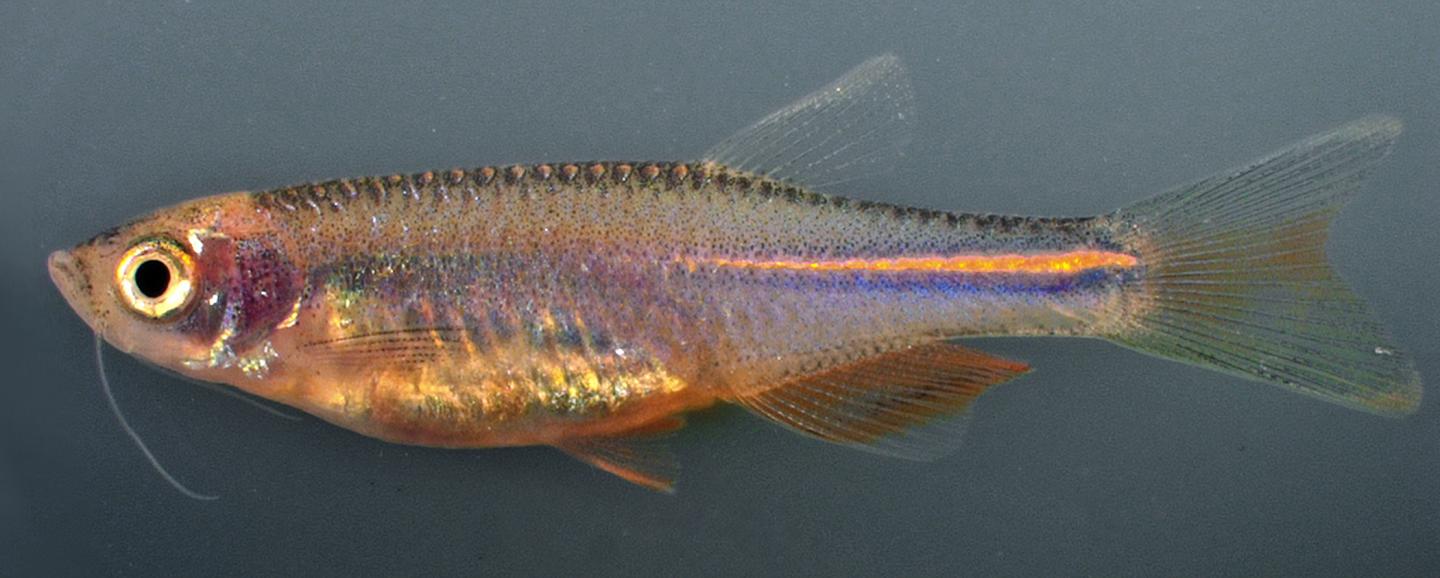

Researchers have determined it's a certain gene that keeps pigment cells dispersed and gives the pearl danio its uniform orange color. By expressing this gene the same way in zebrafish, the zebrafish pigment cells also remained intermingled and the fish were essentially stripped of their stripes.
Credit: D Parichy Lab/U of Washington
The findings – the first published Aug. 28 in Science and the latest in the Nov. 6 issue of Nature Communications – give new understanding about genes and cell behaviors that underlie pigment patterns in zebrafish that, in turn, could help unravel the workings of pigment cells in humans and other animals, skin disorders such as melanoma and cell regeneration.
“Using zebrafish as a model, we're at the point where we have a lot of the basic mechanisms, the basic phenomenology of what's going on, so we can start to look at some of these other species that have really different patterns and start to understand them,” said David Parichy, a UW professor of biology and corresponding author on both papers.
Zebrafish, a tropical freshwater fish about 1.5 inches long, belongs to the minnow family and is a popular addition to home aquariums. Adults have long horizontal blue stripes on their sides, hence the reference to “zebra.” These patterns have roles in schooling, mate selection and avoiding predators. Given their importance, scientists have long wanted to know where these pigment cells come from and how they make stripes and other arrangements.
Unlike humans with a single pigment cell type – the amount of melanin that produces color being determined by everyone's individual genetics – there are three pigment cells that make the zebrafish pattern.
Researchers at UW and elsewhere have previously shown that all three types of pigment cells communicate with one another to organize zebrafish stripes and that two of the pigment cells – one that creates black and another silver – come from stem cells.
In the Aug. 28 issue of Science, two papers report that the cells called xanthophores that produce the color orange don't come from stem cells as had long been assumed. Instead, they come from pre-existing cells in the embryo. The UW researchers also determined the surprising process by which this occurs: cells in the embryo first mature into xanthophores and then, when it's time to make stripes, these same cells lose their color, increase in number and then turn back into xanthophores with color.
“This is remarkable because cells do not normally lose their mature properties, let alone regain them later,” Parichy said. “Knowing how xanthophores achieve this feat could provide clues to regeneration of tissues and organs without the need for stem cells.”
Even more remarkably, the UW authors found that the re-development of orange-producing xanthophores requires thyroid hormone, the same hormone that turns tadpoles into frogs, suggesting that xanthophores undergo their own metamorphosis. At the same time thyroid hormone blocks development of the black cells, setting the proper shade overall.
“In the last 10 to 15 years people trying to understand these patterns have concentrated on how the three pigment cell types interact with each other. We showed the tremendous dependence on thyroid hormone for the pattern that develops,” Parichy said.
Lead author is Sarah McMenamin, a postdoctoral fellow in Parichy's lab. Funding for the work was provided by the National Institutes of Health, which just awarded Parichy a new $1.25 million grant to study thyroid hormone signaling in pigmentation and melanoma.
Next in the Nature Communications paper, Parichy's group reports on a gene that drives the unusually early appearance of xanthophores – independent of thyroid hormone – in another species, the pearl danio. Unlike zebrafish this species lacks stripes: its pigment cells are intermingled and arranged uniformly on the body, giving it a pearly orange color.
By expressing this gene the same way in zebrafish, the researchers caused the fish to make extra-early xanthophores and the fish produced a uniform pattern like the pearl danio instead of their usual stripes.
“Really simple changes in timing make totally different patterns,” Parichy said.
This unexpected result shows that a core network of interacting cells can generate very different patterns in response to changes in timing, a discovery that could explain color pattern evolution across a variety of species. Lead author on the Nature Communications paper is postdoctoral scholar Larissa Patterson and the work was funded by the NIH.
“If you'd asked me five years ago if we're in a position to have some useful hypotheses about where patterns come from in other species, I'd have said, 'No,'” Parichy said. “But I think now we're really at the point where we understand a lot of the basics and we can start to frame testable hypotheses. We can see how much of this is just a simple difference in timing, a difference in thyroid hormone responsiveness or a difference in cellular communication itself.”
Patterson and UW's Emily Bain are co-authors on both papers. Other co-authors on the Science paper are UW's Anna McCann, Dae Seok Eom, and undergraduates Zachary Waller and James Hamill, as well as Julie Kuhlman from Iowa State University and Judith Eisen of the University of Oregon.
For more information you can contact Parichy at dparichy@uw.edu or 206-734-7331.
Suggested Websites
“Thyroid hormone–dependent adult pigment cell lineage and pattern in zebrafish” Aug. 28, 2014, Science online: http://www.sciencemag.org/content/345/6202/1358.abstract
“Pigment-cell interactions and differential xanthophores recruitment underlying zebrafish stripe reiteration and Danio pattern evolution” Scheduled for Nov. 6, 2014, Nature Communications: http://www.nature.com/naturecommunications
Parichy lab: http://faculty.washington.edu/dparichy/Index.html















